Utilizing an Adaptive Neuro-Fuzzy Inference System (ANFIS) for Overcrowding Level Risk Assessment in Railway Stations
Abstract
:1. Introduction
- Many models consider the total number of passengers entering a station. However, overcrowding may occur only on one platform. In our study, we consider the number of passengers on a single platform that is determined by the passengers in waiting and the flow from the station to the platform through the escalators or other channels. Additionally, we assume that the delay of one train can affect only one platform. The information fed to the model can be captured from images in the station that include the spatial and temporal dependence of the crowd.
- The ANFIS model used in this study can learn and specify a threshold for the risk level depending on location and crowd standards from accurate real-time data.
- Estimating the risk level is an important outcome of our prediction, unlike traditional prediction studies that focus only on station-level or route-level forecasting (time series).
2. Literature Review
- The risk and consequences of the unwanted events (crowd) must be considered, such as stamping and falling or panicking.
- Real data is essential and will reduce error compared to simulation data.
- Time series models usually neglect many factors and specific locations, such as the platforms in railway stations.
- Appling AI to existing systems in railway stations, such as closed-circuit television CCTV, will be beneficial and cost efficient to operators for timely flow prediction.
- Certain passenger categories, such as the disabled, families, and the elderly, need to be considered to make stations accessible to all.
3. Intelligent System for Managing Risks (ISFMR)
4. Overcrowding at Railway Stations
5. Development of the ANFIS Model and the Framework
- Rule 1: If x is A1 and y is B1, THEN f1 = c1x+q1 y+ R1
- Rule 2: If x is A2 and y is B2, THEN f2 = c2x+q2 y+ R2
6. Explanation of the ANFIS Model and the Framework
- Train departure
- Train arrival
- Train departure
- Monitoring the station to provide early precaution of overcrowding risk,
- Flexibility in reaction to overcrowding risk,
- Comparative learning technique of station resources in response to the overcrowding risk,
- Can be an intelligent system with the perspective of the ISFMR,
- Can be based on on-hand data from digital sources, which can be gathered in real time,
- Small scale, which can be generalised for more than just overcrowding risk levels.
- Stranded passengers (platform).
- Transfer efficiency (channel), with each level grouped to an equivalent degree of risk.
7. Results and Analysis
8. Conclusions
Author Contributions
Funding
Acknowledgments
Conflicts of Interest
References
- Asada, T.; Roberts, C.; Koseki, T. An algorithm for improved performance of railway condition monitoring equipment: Alternating-current point machine case study. Transp. Res. Part C Emerg. Technol. 2013, 30, 81–92. [Google Scholar] [CrossRef]
- Chen, S.; Di, Y.; Liu, S.; Wang, B. Modelling and analysis on emergency evacuation from metro stations. Math. Probl. Eng. 2017, 2017. [Google Scholar] [CrossRef]
- Lu, K.; Han, B.; Lu, F.; Wang, Z. Urban rail transit in China: Progress report and analysis (2008–2015). Urban Rail Transit 2016, 2, 93–105. [Google Scholar] [CrossRef] [Green Version]
- Munro, A. HS2 railway, UK—Why the country needs it. Proc. Inst. Civ. Eng. Transp. 2018, 1–9. [Google Scholar] [CrossRef]
- Crompton, G.; Jupe, R. Delivering better transport? An evaluation of the ten-year plan for the railway industry. Public Money Manag. 2002, 22, 41–48. [Google Scholar] [CrossRef]
- Gavin, K.; Oslakovic, I.S.; Vajdic, M.; Puz, G.; Sporcic, V. Smart maintenance and analysis of railway transport infrastructure (smart rail). In Proceedings of the 2nd International Conference on Road and Rail Infrastructure, Dubrovnik, Croatia, 7–9 May 2012; pp. 429–435. [Google Scholar]
- Gershon, R.R.M.; Qureshi, K.A.; Barrera, M.A.; Erwin, M.J.; Goldsmith, F. Health and safety hazards associated with subways: A review. J. Urban Heal. 2005, 82, 10–20. [Google Scholar] [CrossRef] [Green Version]
- Lathia, N.; Capra, L. How Smart is your smartcard? Measuring travel behaviours, perceptions, and incentives. In Proceedings of the 13th International Conference on Ubiquitous Information Management and Communication, Beijing, China, 17–21 September 2011. [Google Scholar]
- Alawad, H.; Kaewunruen, S. Wireless sensor networks: Toward smarter railway stations. Infrastructures 2018, 3, 24. [Google Scholar] [CrossRef] [Green Version]
- Chen, M.C.; Wei, Y. Exploring time variants for short-term passenger flow. J. Transp. Geogr. 2011, 19, 488–498. [Google Scholar] [CrossRef]
- Xie, P.; Li, T.; Liu, J.; Du, S.; Yang, X.; Zhang, J. Urban flows prediction from spatiotemporal data using machine learning: A survey. Inf. Fusion 2020, 59, 1–12. [Google Scholar] [CrossRef]
- Cox, T.; Houdmont, J.; Griffiths, A. Rail passenger crowding, stress, health and safety in Britain. Transp. Res. Part A Policy Pract. 2006, 40, 244–258. [Google Scholar] [CrossRef] [Green Version]
- Kabalan, B.; Leurent, F.; Christoforou, Z.; Dubroca-Voisin, M. Framework for centralized and dynamic pedestrian management in railway stations. Transp. Res. Proc. 2017, 27, 712–719. [Google Scholar] [CrossRef]
- An, M.; Chen, Y.; Baker, C.J. A fuzzy reasoning and fuzzy-analytical hierarchy process based approach to the process of railway risk information: A railway risk management system. Inf. Sci. 2011, 181, 3946–3966. [Google Scholar] [CrossRef] [Green Version]
- Davies, A.C. Crowd monitoring using image processing. Electron. Commun. Eng. J. 1995, 7, 37–47. [Google Scholar] [CrossRef] [Green Version]
- Alawad, H.; Codru, S.; Kaewunruen, S. Complex-system decision framework for managing risks to rail stations at airports from terrorist threats. In Proceedings of the 5th International Conference on Road and Rail Infrastructure, Zadar, Croatia, 17–19 May 2018; Volume 5, pp. 855–861. [Google Scholar]
- Lu, K.; Han, B. Congestion risk evaluation and precaution of passenger flow in metro stations. Open Civ. Eng. J. 2016, 10, 93–104. [Google Scholar] [CrossRef] [Green Version]
- Zhu, B.; Liu, T.; Tang, Y. Research on pedestrian evacuation simulation based on fuzzy logic. In Proceedings of the 2008 9th International Conference on Computer-Aided Industrial Design and Conceptual Design, Kunming, China, 22–25 November 2008; pp. 1024–1029. [Google Scholar] [CrossRef]
- Ibrahim, A.M.; Venkat, I.; Subramanian, K.G.; Khader, A.T.; De Wilde, P. Intelligent evacuation management systems: A review. ACM Trans. Intell. Syst. Technol. 2016, 7. [Google Scholar] [CrossRef]
- Boulet, X.; Zargayouna, M.; Leurent, F.; Kabalan, B.; Ksontini, F. A dynamic multiagent simulation of mobility in a train station. Transp. Res. Procedia 2017, 27, 744–751. [Google Scholar] [CrossRef]
- Wei, Y.; Chen, M.-C. Forecasting the short-term metro passenger flow with empirical mode decomposition and neural networks. Transp. Res. Part C Emerg. Technol. 2012. [Google Scholar] [CrossRef]
- Tirachini, A.; Hensher, D.A.; Rose, J.M. Crowding in public transport systems: Effects on users, operation and implications for the estimation of demand. Transp. Res. Part A Policy Pract. 2013, 53, 36–52. [Google Scholar] [CrossRef]
- Katz, D.; Rahman, M. Levels of overcrowding in bus system of Dhaka, Bangladesh. Transp. Res. Record J. Transp. Res. Board 2010, 85–91. [Google Scholar] [CrossRef]
- Cheng, Y.H. Exploring passenger anxiety associated with train travel. Transportation (Amst.) 2010, 37, 875–896. [Google Scholar] [CrossRef]
- Mohd Mahudin, N.D.; Cox, T.; Griffiths, A. Measuring rail passenger crowding: Scale development and psychometric properties. Transp. Res. Part F Traffic Psychol. Behav. 2012, 15, 38–51. [Google Scholar] [CrossRef]
- Rose, W. Modelling the impact of alternative fare structures on train overcrowding. In Proceedings of the European Transport Conference, Strasbourg, France, 8–10 October 2003. [Google Scholar]
- Zhang, Y.; Han, J.; Liu, J.; Zhou, T.; Suni, J.; Luo, J. Safety prediction of rail transit system based on deep learning. In Proceedings of the 16th IEEE/ACIS International Conference on Computer and Information Science, Wuhan, China, 24–26 May 2017; pp. 851–856. [Google Scholar]
- Ma, S.; Weng, J.; Wang, C.; Alivanistos, D.; Lin, P. Bus passenger flow congestion risk evaluation model based on the pressure-state-response framework: A case study in Beijing. Artic. Sci. Prog. Sci. Prog. 2020, 103, 1–14. [Google Scholar] [CrossRef] [PubMed]
- Ning, Y.; Huang, Y.; Li, J.; Liu, Q.; Yang, D.; Zheng, W.; Liu, H. ST-DRN: Deep residual networks for spatio-temporal metro stations crowd flows forecast. In Proceedings of the 2018 International Joint Conference on Neural Networks (IJCNN), Rio de Janeiro, Brazil, 8–13 July 2018. [Google Scholar] [CrossRef]
- Lu, L.; Peng, H. Research on urban rail transit operation safety evaluation system based on ISM. In Proceedings of the APCIM & ICTTE 2018, Beijing, China, 21–23 December 2018; pp. 72–75. [Google Scholar]
- Dinmohammadi, F.; Alkali, B.; Shafiee, M.; Bérenguer, C.; Labib, A. Risk evaluation of railway rolling stock failures using FMECA technique: A case study of passenger door system. Urban Rail Transit 2016, 2, 128–145. [Google Scholar] [CrossRef] [Green Version]
- Lan, Y.J.; Han, B.M.; Li, D.W. Research on safety risk assessment of large-scale railway passenger station. Appl. Mech. Mater. 2013, 361–363, 1923–1926. [Google Scholar] [CrossRef]
- Huang, Z.; Xu, R.; Zhou, F. A multilevel fuzzy comprehensive evaluation model for operation safety of the large high-speed railway passenger station. In Proceedings of the 2017 4th International Conference on Transportation Information and Safety, Banff, AB, Canada, 8–10 August 2017; pp. 844–851. [Google Scholar]
- Liu, Y.; Wang, T.; Ding, H.; Wu, Z. Research and application on risk assessment DEA model of crowd crushing and trampling accidents in subway stations. Proc. Eng. 2012, 43, 494–498. [Google Scholar]
- Xu, H.; Zhang, Y.; Li, H.; Skitmore, M.; Yang, J.; Yu, F. Safety risks in rail stations: An interactive approach. J. Rail Transp. Plan. Manag. 2019, 11, 100148. [Google Scholar] [CrossRef]
- Zhang, X.; Deng, Y.; Li, Q.; Skitmore, M.; Zhou, Z. An incident database for improving metro safety: The case of shanghai. Saf. Sci. 2016, 84, 88–96. [Google Scholar] [CrossRef] [Green Version]
- Gu, X.; Zhang, L.; Li, D.; Ma, L. Analysis on operation risk factors of urban rail transit based on fuzzy analytical hierarchy process. In Proceedings of the 2012 International Conference on Information Management, Innovation Management and Industrial Engineering, Sanya, China, 20–21 October 2012; Volume 3, pp. 214–218. [Google Scholar]
- Zhang, H.; Sun, Q. An integrated MCDM approach to train derailment risk response strategy selection. Symmetry (Basel) 2020, 12, 47. [Google Scholar] [CrossRef] [Green Version]
- Sun, Y.; Zhang, G.; Yin, H. Passenger flow prediction of subway transfer stations based on nonparametric regression model. Discret. Dyn. Nat. Soc. 2014, 2014. [Google Scholar] [CrossRef]
- Tu, Q.; Weng, J.C.; Wang, C. A dynamic identification method of passenger flow congestion risk in rail transit hub station based on grey clustering. In Proceedings of the 2017 4th International Conference on Transportation Information and Safety, Banff, AB, Canada, 8–10 August 2017; pp. 806–811. [Google Scholar]
- Huang, W.; Zhang, Y. Railway dangerous goods transportation system risk assessment: An approach combining FMEA with pessimistic–optimistic fuzzy information axiom considering acceptable risk coefficient. IEEE Trans. Reliab. 2020. [Google Scholar] [CrossRef]
- Tang, S.; Gao, H. Traffic-incident detection-algorithm based on nonparametric regression. IEEE Trans. Intell. Transp. Syst. 2005, 6, 38–42. [Google Scholar] [CrossRef]
- Gong, Y.; Li, Z.; Zhang, J.; Liu, W.; Zheng, Y. Online spatio-temporal crowd flow distribution prediction for complex metro system. IEEE Trans. Knowl. Data Eng. 2020, 1. [Google Scholar] [CrossRef]
- Guo, J.; Xie, Z.; Qin, Y.; Jia, L.; Wang, Y. Short-term abnormal passenger flow prediction based on the fusion of SVR and LSTM. IEEE Access 2019, 7, 42946–42955. [Google Scholar] [CrossRef]
- Zhang, Q.; Zhuang, Y.; Wei, Y.; Jiang, H.; Yang, H. Railway safety risk assessment and control optimization method based on FTA-FPN: A case study of chinese high-speed railway station. J. Adv. Transp. 2020, 2020. [Google Scholar] [CrossRef]
- Guo, J.; Xie, Z.; Li, Q.; Zhan, S.; Xu, J. Railway passenger flow recognition algorithm for terminal station based on cost theory and automatic frequency control. IEEE Access 2020, 8, 26885–26892. [Google Scholar] [CrossRef]
- Heidarysafa, M.; Kowsari, K.; Barnes, L.; Brown, D. Analysis of railway accidents’ narratives using deep learning. In Proceedings of the 17th IEEE International Conference on Machine Learning and Applications, Orlando, FL, USA, 17–20 December 2018; pp. 1446–1453. [Google Scholar]
- Li, Y.; Wang, X.; Sun, S.; Ma, X.; Lu, G. Forecasting short-term subway passenger flow under special events scenarios using multiscale radial basis function networks. Transp. Res. Part C Emerg. Technol. 2017, 77, 306–328. [Google Scholar] [CrossRef]
- Alawad, H.; Kaewunruen, S.; An, M. Learning from accidents: Machine learning for safety at railway stations. IEEE Access 2020, 8, 633–648. [Google Scholar] [CrossRef]
- Hua, L.; Zheng, W.; Gao, S. Extraction and analysis of risk factors from Chinese railway accident reports. In Proceedings of the 2019 IEEE Intelligent Transportation Systems Conference, ITSC, Auckland, New Zealand, 27–30 October 2019; pp. 869–874. [Google Scholar]
- Liu, P.; Xie, M.; Bian, J.; Li, H.; Song, L. A hybrid PSO–SVM model based on safety risk prediction for the design process in metro station construction. Int. J. Environ. Res. Public Health 2020, 17, 1714. [Google Scholar] [CrossRef] [Green Version]
- Noor Syeda, K.; Noorulhassan Shirazi, S.; Asad Ali Naqvi, S.; Parkinson, H.J.; Bamford, G. Big Data and Natural Language Processing for Analysing Railway Safety. In Innovative Applications of Big Data in the Railway Industry; IGI Global Publishing: Hershey, PA, USA, 2017. [Google Scholar]
- Coppola, P.; Silvestri, F. Assessing travelers’ safety and security perception in railway stations. Case Stud. Transp. Policy 2020. [Google Scholar] [CrossRef]
- Gintschel, S.; Kirawanich, P. A risk-based analysis of design practices in regard to passenger hazard exposure in open mass transit stations. Urban Rail Transit 2020, 6, 15–27. [Google Scholar] [CrossRef] [Green Version]
- Ying, M.; Kaminishi, K.; Duysters, G.; De Hoyos, A.; Takala, J.; Yusof, R. The Safety Risk Assessment of Railway Station under Terrorist Attacks Based on AHP, 2016; ISBN 9787562956600.
- Ding, X.; Yang, X.; Hu, H.; Liu, Z. The safety management of urban rail transit based on operation fault log. Saf. Sci. 2017, 94, 10–16. [Google Scholar] [CrossRef]
- Chen, W.; Zhang, Y.; Khasawneh, M.T.; Geng, Z. Risk analysis on Beijing metro operation initiated by human factors. J. Transp. Saf. Secur. 2019, 11, 683–699. [Google Scholar] [CrossRef]
- Peng, W.; Lin, Z. Research on risk assessment of railway freight station based on nonlinear combination of ahp-entropy. In Proceedings of the 2018 15th International Conference on Service Systems and Service Management, ICSSSM, Hangzhou, China, 21–22 July 2018. [Google Scholar]
- Liu, Y.; Liu, Z.; Jia, R. DeepPF: A deep learning based architecture for metro passenger flow prediction. Transp. Res. Part C Emerg. Technol. 2019, 101, 18–34. [Google Scholar] [CrossRef]
- Lv, Y.; Duan, Y.; Kang, W.; Li, Z.; Wang, F.Y. Traffic flow prediction with big data: A deep learning approach. IEEE Trans. Intell. Transp. Syst. 2015, 16, 865–873. [Google Scholar] [CrossRef]
- Jiang, R.; Song, X.; Wang, Z.; Huang, D.; Song, X.; Kim, K.S.; Xia, T.; Cai, Z.; Shibasaki, R. Deepurbanevent: A system for predicting citywide crowd dynamics at big events. In Proceedings of the 25th ACM SIGKDD International Conference on Knowledge Discovery & Data Mining, Anchorage, AK, USA, 4–8 August 2019; pp. 2114–2122. [Google Scholar] [CrossRef]
- Alawad, H.; Kaewunruen, S.; An, M. A Deep Learning Approach Towards Railway Safety Risk Assessment. IEEE Access 2020, 8, 102811–102832. [Google Scholar] [CrossRef]
- Lopez, A.J.; Semanjski, I.; Gautama, S.; Ochoa, D. Assessment of smartphone positioning data quality in the scope of citizen science contributions. Mob. Inf. Syst. 2017, 2017. [Google Scholar] [CrossRef] [Green Version]
- Van Den Heuvel, J.P.A.; Hoogenraad, J.H. Monitoring the performance of the pedestrian transfer function of train stations using automatic fare collection data. Transp. Res. Procedia 2014, 2, 642–650. [Google Scholar] [CrossRef] [Green Version]
- Van Den Heuvel, J.; Voskamp, A.; Daamen, W.; Hoogendoorn, S.P. Using bluetooth to estimate the impact of congestion on pedestrian route choice at train stations. In Traffic and Granular Flow ‘13; Springer International Publishing: Cham, Switzerland, 2015; pp. 73–82. [Google Scholar]
- Ganansia, F.; Carincotte, C.; Descamps, A.; Chaudy, C. A promising approach to people flow assessment in railway stations using standard CCTV networks. In Proceedings of the Transport Research Arena (TRA), Paris, France, 14–17 April 2014; pp. 1–10. [Google Scholar]
- Kaewunruen, S.; Alawad, H.; Cotruta, S. A Decision Framework for Managing the Risk of Terrorist Threats at Rail Stations Interconnected with Airports. Safety 2018, 4, 36. [Google Scholar] [CrossRef] [Green Version]
- Ceapa, I.; Smith, C.; Capra, L. Avoiding the crowds: Understanding Tube station congestion patterns from trip data. In Proceedings of the ACM SIGKDD International Conference on Knowledge Discovery and Data Mining, Beijing, China, 12–16 August 2012; pp. 134–141. [Google Scholar]
- Health and Safety Laboratory. Health and Safety Effects of Crowding; Rail Safety and Standards Board: London, UK, 2005.
- Rail Safety and Standards Board Limited. RIS-3703-TOM/3:2017—Passenger Train Dispatch and Platform Safety Measures; Rail Safety and Standards Board: London, UK, 2017. [Google Scholar]
- Helbing, D.; Johansson, A.; Al-Abideen, H.Z. Dynamics of crowd disasters: An empirical study. Phys. Rev. E Stat. Nonlinear, Soft Matter Phys. 2007, 75. [Google Scholar] [CrossRef] [PubMed] [Green Version]
- Feng, S.; Shen, C.; Xia, N.; Song, W.; Fan, M.; Cowling, B.J. Rational use of face masks in the COVID-19 pandemic. Lancet Respir. Med. 2020, 8, 434–436. [Google Scholar] [CrossRef]
- Helbing, D.; Molnár, P. Social force model for pedestrian dynamics. Phys. Rev. E 1995, 51, 4282–4286. [Google Scholar] [CrossRef] [Green Version]
- Ning, B.; Dong, H.R.; Wen, D.; Li, L.; Cheng, C.J. ACP-based control and management of urban rail transportation systems. IEEE Intell. Syst. 2011, 26, 84–88. [Google Scholar] [CrossRef]
- Dindar, S.; Kaewunruen, S.; An, M. Rail accident analysis using large-scale investigations of train derailments on switches and crossings: Comparing the performances of a novel stochastic mathematical prediction and various assumptions. Eng. Fail. Anal. 2019, 103, 203–216. [Google Scholar] [CrossRef]
- Dindar, S.; Kaewunruen, S.; An, M. Bayesian network-based human error reliability assessment of derailments. Reliab. Eng. Sys. Safe. 2020, 197, 106825. [Google Scholar] [CrossRef]
- Mohd Mahudin, N.D.; Cox, T.; Griffiths, A. Modelling the spillover effects of rail passenger crowding on individual well being and organisational behaviour. WIT Trans. Built Environ. 2011, 116, 227–238. [Google Scholar] [CrossRef] [Green Version]
- Negnevitsky, M. Artificial Intelligence—A Guide to Intelligent Systems; Addison Wesley: Boston, MA, USA, 2002; Volume 110, ISBN 0321204662. [Google Scholar]
- Jang, J.S.R. Self-learning fuzzy controllers based on temporal back propagation. IEEE Trans. Neural Networks 1992, 3, 714–723. [Google Scholar] [CrossRef] [Green Version]
- Jang, J.S.R. ANFIS: Adaptive-network-based fuzzy inference system. IEEE Trans. Syst. Man Cybern. 1993, 23, 665–685. [Google Scholar] [CrossRef]
- Mitra, S.; Hayashi, Y.; Member, S. Neuro-fuzzy rule generation: Survey in soft computing network. IEEE Trans. Neural Netw. 2000, 11, 748–768. [Google Scholar] [CrossRef] [Green Version]
- Feng, G. A survey on analysis and design of model-based fuzzy control systems. IEEE Trans. Fuzzy Syst. 2006, 14, 676–697. [Google Scholar] [CrossRef] [Green Version]
- Shihabudheen, K.V.; Pillai, G.N. Recent advances in neuro-fuzzy system: A survey. Knowl. Based Syst. 2018, 152, 136–162. [Google Scholar] [CrossRef]
- Nelles, O. Nonlinear System Identification; Springer: Heidelberg/Berlin, Germany, 2001; ISBN 3540673695. [Google Scholar]
- Vieira, J.; Dias, F.; Mota, A. Neuro-fuzzy systems: A survey. WSEAS Trans. Syst. 2004, 3, 414–419. [Google Scholar]
- Ebrat, M.; Ghodsi, R. Construction project risk assessment by using adaptive-network-based fuzzy inference system: An empirical study. KSCE J. Civ. Eng. 2014, 18, 1213–1227. [Google Scholar] [CrossRef]
- Zhu, W.; Cao, D. Expressway management risk evaluation based on fuzzy neural networks. In Proceedings of the 2009 Second International Conference on Intelligent Computation Technology and Automation, Changsha, Hunan, China, 10–11 October 2009; pp. 700–703. [Google Scholar] [CrossRef]
- Şamandar, A. A model of adaptive neural-based fuzzy inference system (ANFIS) for prediction of friction coefficient in open channel flow. Sci. Res. Essays 2011, 6, 1020–1027. [Google Scholar] [CrossRef]
- Zhou, Q.; Wong, Y.D.; Loh, H.S.; Yuen, K.F. ANFIS model for assessing near-miss risk during tanker shipping voyages. Marit. Policy Manag. 2019, 46, 377–393. [Google Scholar] [CrossRef]
- Osman, M.; Kaewunruen, S. Value of rescheduling of rail inspection. Proc. Inst. Mech. Eng. Part F J. Rail Rapid Transit 2020, 234, 321–330. [Google Scholar] [CrossRef]
- Öztaysi, B.; Behret, H.; Kabak, Ö.; Sarı, I.U.; Kahraman, C. Fuzzy inference systems for disaster response. In Decision Aid Models for Disaster Management and Emergencies; Atlantis Press: Paris, France, 2013; pp. 75–94. [Google Scholar]
- Ebrat, M.; Ghodsi, R. Risk assessment of construction projects using network based adaptive fuzzy system. Int. J. Acad. Res. 2011, 3, 411–417. [Google Scholar]
- Zhao, J.; Bose, B.K. Evaluation of membership functions for fuzzy logic controlled induction motor drive. In Proceedings of the IEEE 2002 28th Annual Conference of the Industrial Electronics Society, IECON 02, Sevilla, Spain, 5–8 November 2002; pp. 229–234. [Google Scholar] [CrossRef]
- Nedjah, N.; Mourelle, L.d.M. Fuzzy Systems Engineering: Theory and Practice; Springer: Heidelberg/Berlin, Germany, 2006. [Google Scholar]
- Kaur, A.; Kaur, A. Comparison of Mamdani-type and Sugeno-type fuzzy inference systems for air conditioning system. Int. J. Soft Comput. Eng. 2012, 2, 323–325. [Google Scholar]
- Shoorehdeli, M.A.; Teshnehlab, M.; Sedigh, A.K.; Khanesar, M.A. Identification using ANFIS with intelligent hybrid stable learning algorithm approaches and stability analysis of training methods. Appl. Soft Comput. J. 2009, 9, 833–850. [Google Scholar] [CrossRef]
- Takagi, T.; Sugeno, M. Fuzzy identification of systems and its applications to modeling and control. IEEE Trans. Syst. Man Cybern. 1985, SMC-15, 116–132. [Google Scholar] [CrossRef]
- Kumar, S.; Taheri, F. Neuro-fuzzy approaches for pipeline condition assessment. Nondestruct. Test. Eval. 2007, 22, 35–60. [Google Scholar] [CrossRef]
- Kaynak, S.; Evirgen, H.; Kaynak, B. Adaptive neuro-fuzzy inference system in predicting the success of student’s in a particular course. Int. J. Comput. Theory Eng. 2014, 7, 34–39. [Google Scholar] [CrossRef] [Green Version]
- Babuška, R.; Verbruggen, H. Neuro-fuzzy methods for nonlinear system identification. Annu. Rev. Control 2003, 27, 73–85. [Google Scholar] [CrossRef]
- Li, J.P. Train station passenger flow study. Winter Simul. Conf. Proc. 2000, 2, 1173–1176. [Google Scholar] [CrossRef]
- Wang, S.W.; Sun, L.S.; Rong, J.; Yang, Z.F. Transit station congestion index research based on pedestrian simulation and gray clustering evaluation. Discret. Dyn. Nat. Soc. 2013, 2013. [Google Scholar] [CrossRef]
- Gu, Z.; Osaragi, T.; Lu, W. Simulating pedestrians’ spatio-temporal distribution in underground spaces. Sustain. Cities Soc. 2019, 48, 101552. [Google Scholar] [CrossRef]
- Seer, S.; Bauer, D.; Brändle, N.; Ray, M. Estimating pedestrian movement characteristics for crowd control at public transport facilities. In Proceedings of the 2008 11th International IEEE Conference on Intelligent Transportation Systems, Beijing, China, 12–15 October 2008; pp. 742–747. [Google Scholar] [CrossRef]
- Fang, Z.; Yuan, J.P.; Wang, Y.C.; Lo, S.M. Survey of pedestrian movement and development of a crowd dynamics model. Fire Saf. J. 2008, 43, 459–465. [Google Scholar] [CrossRef]
- Hankin, B.D.; Wright, R.A. Passenger flow in subways. J. Oper. Res. Soc. 1958, 9, 81–88. [Google Scholar] [CrossRef]
- Smith, R.A. Density, velocity and flow relationships for closely packed crowds. Saf. Sci. 1995, 18, 321–327. [Google Scholar] [CrossRef]
- Li, Z.; Hensher, D.A. Crowding in public transport: A review of objective and subjective measures. J. Public Transp. 2013, 16, 107–134. [Google Scholar] [CrossRef]
- Løvås, G.G. Modeling and simulation of pedestrian traffic flow. Transp. Res. Part B 1994, 28, 429–443. [Google Scholar] [CrossRef]
- Ye, J.H.; Chen, X.; Yang, C.; Wu, J. Walking behavior and pedestrian flow characteristics for different types of walking facilities. Transp. Res. Rec. 2008, 43–51. [Google Scholar] [CrossRef]
- Armstrong, J.S.; Collopy, F. Error measures for generalizing about forecasting methods: Empirical comparisons. Int. J. Forecast. 1992, 8, 69–80. [Google Scholar] [CrossRef] [Green Version]
- Binti Sa’adin, S.L.; Kaewunruen, S.; Jaroszweski, D. Operational readiness for climate change of Malaysia high-speed rail. Proc. Inst. Civ. Eng. Transp. 2016, 169, 308–320. [Google Scholar] [CrossRef]
- Sresakoolchai, J.; Kaewunruen, S. Comparative studies into public private partnership and traditional investment approaches on The High-Speed Rail Project Linking 3 Airports in Thailand. Transp. Res. Int. Persp. 2020, 5, 100116. [Google Scholar] [CrossRef]
- Kaewunruen, S.; Sussman, J.M.; Matsumoto, A. Grand challenges in transportation and transit systems. Front. Built Environ. 2016, 2, 1–5. [Google Scholar] [CrossRef] [Green Version]
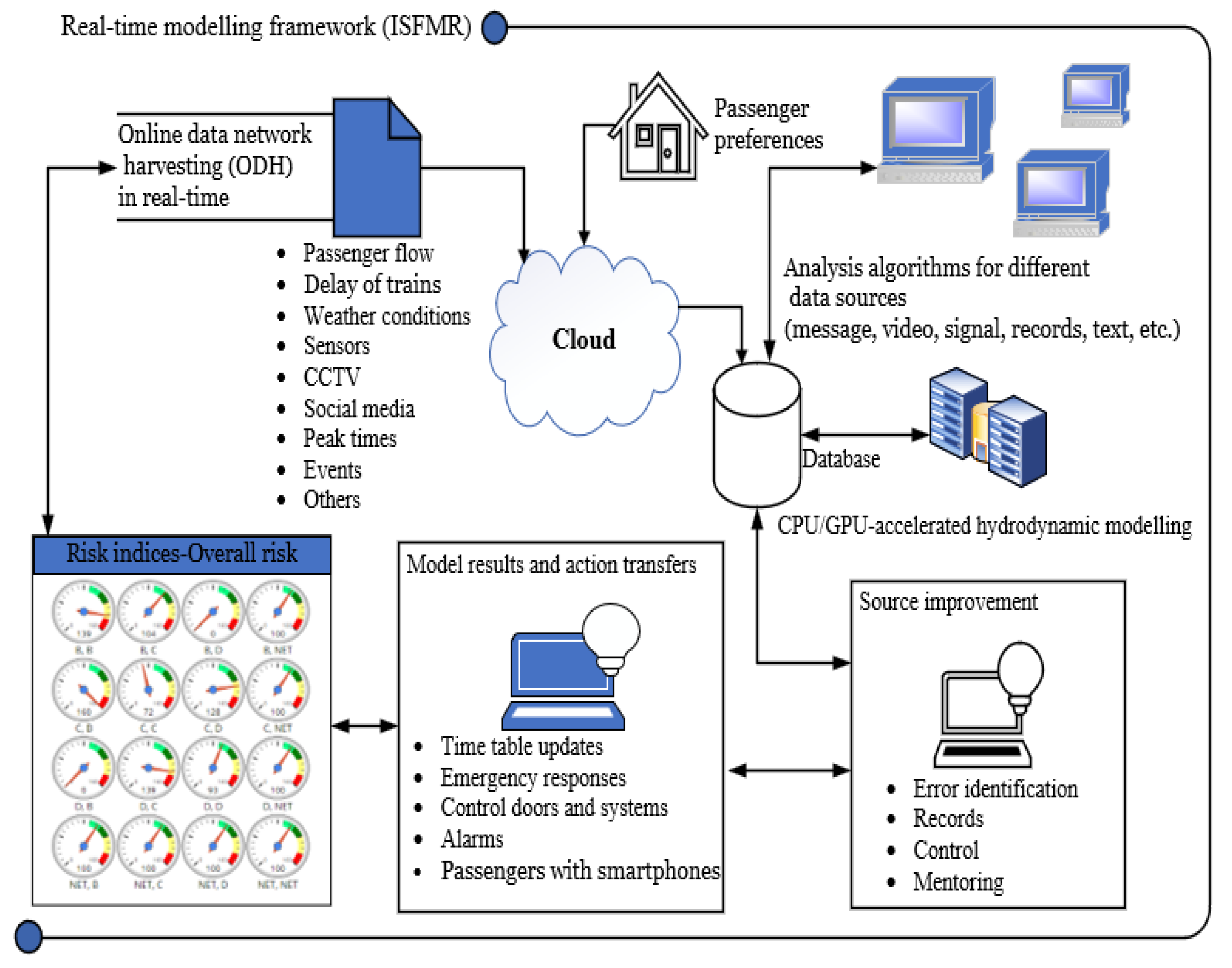
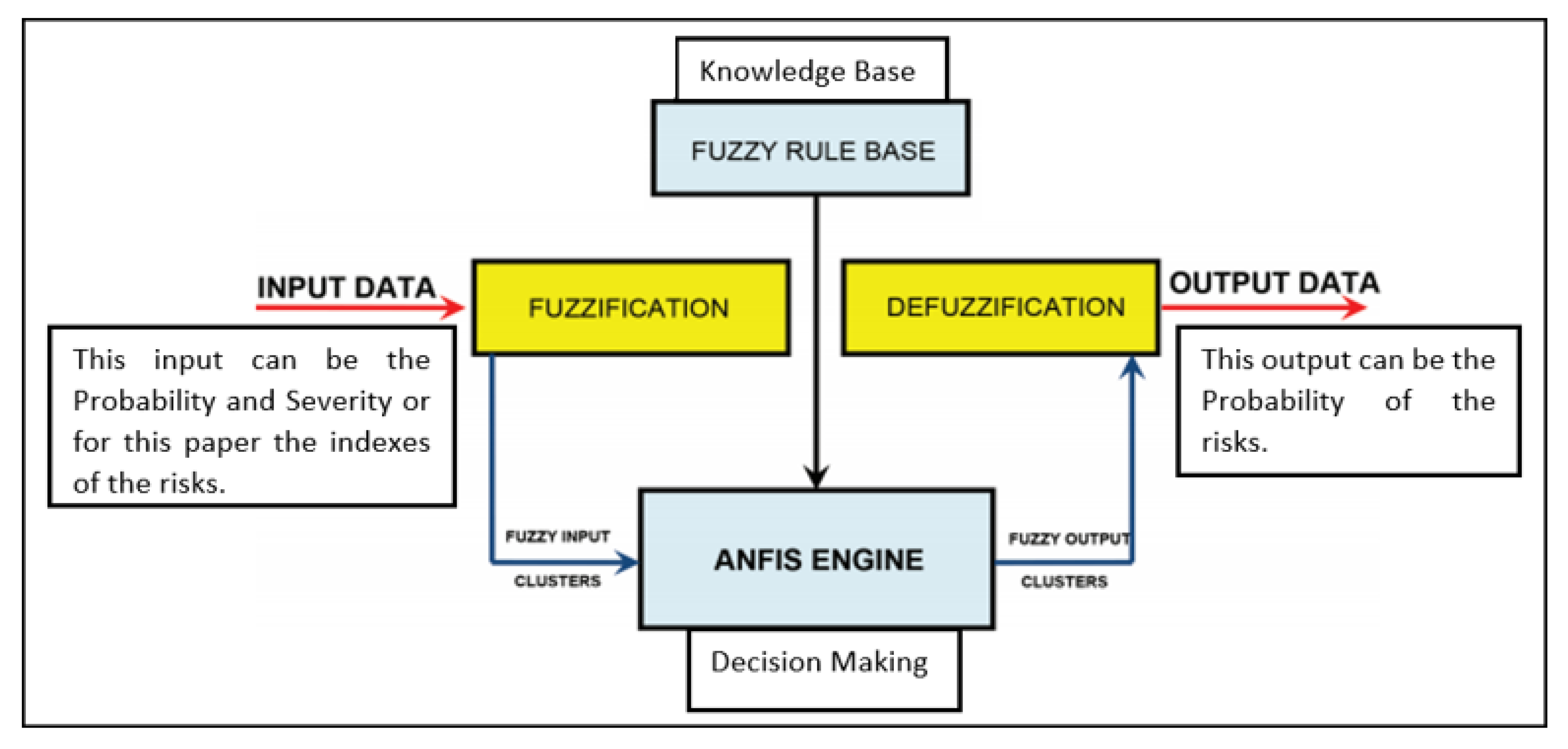
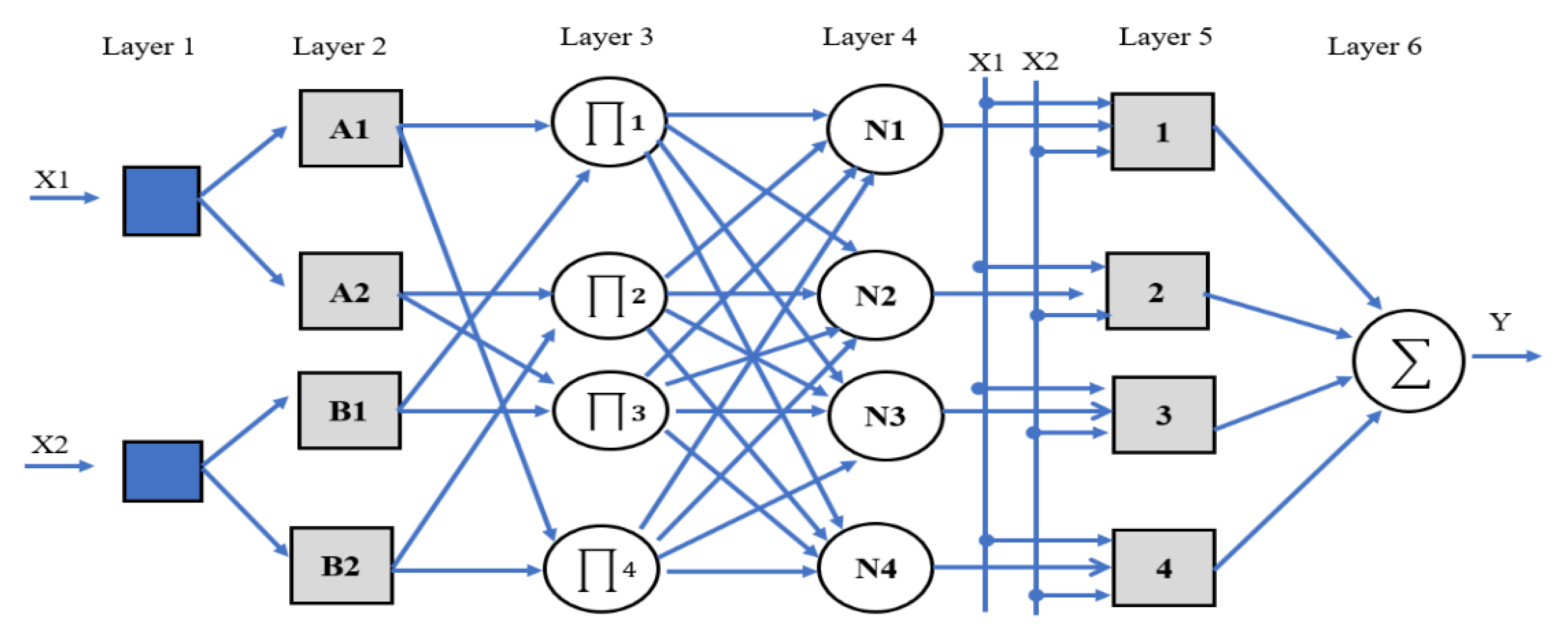

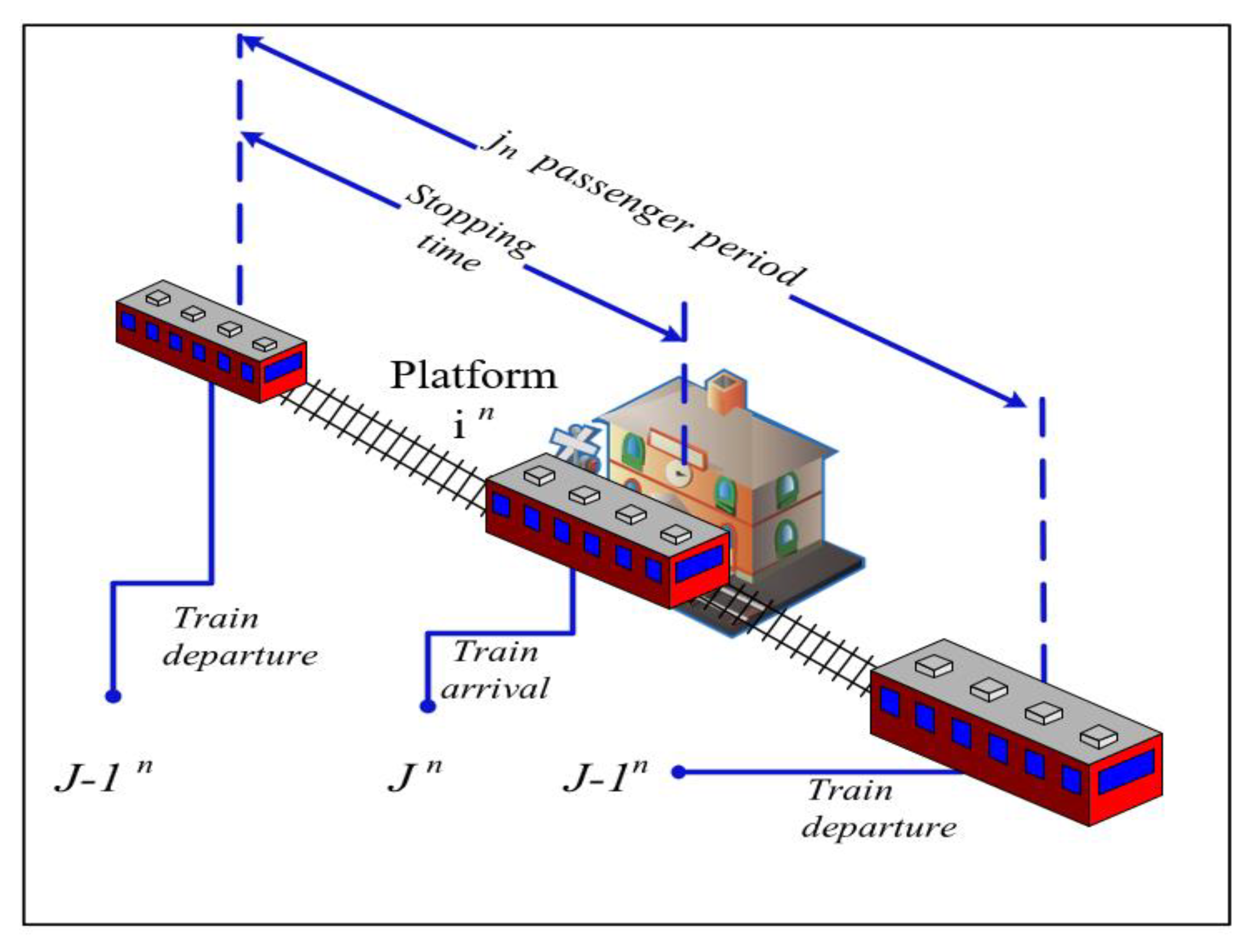
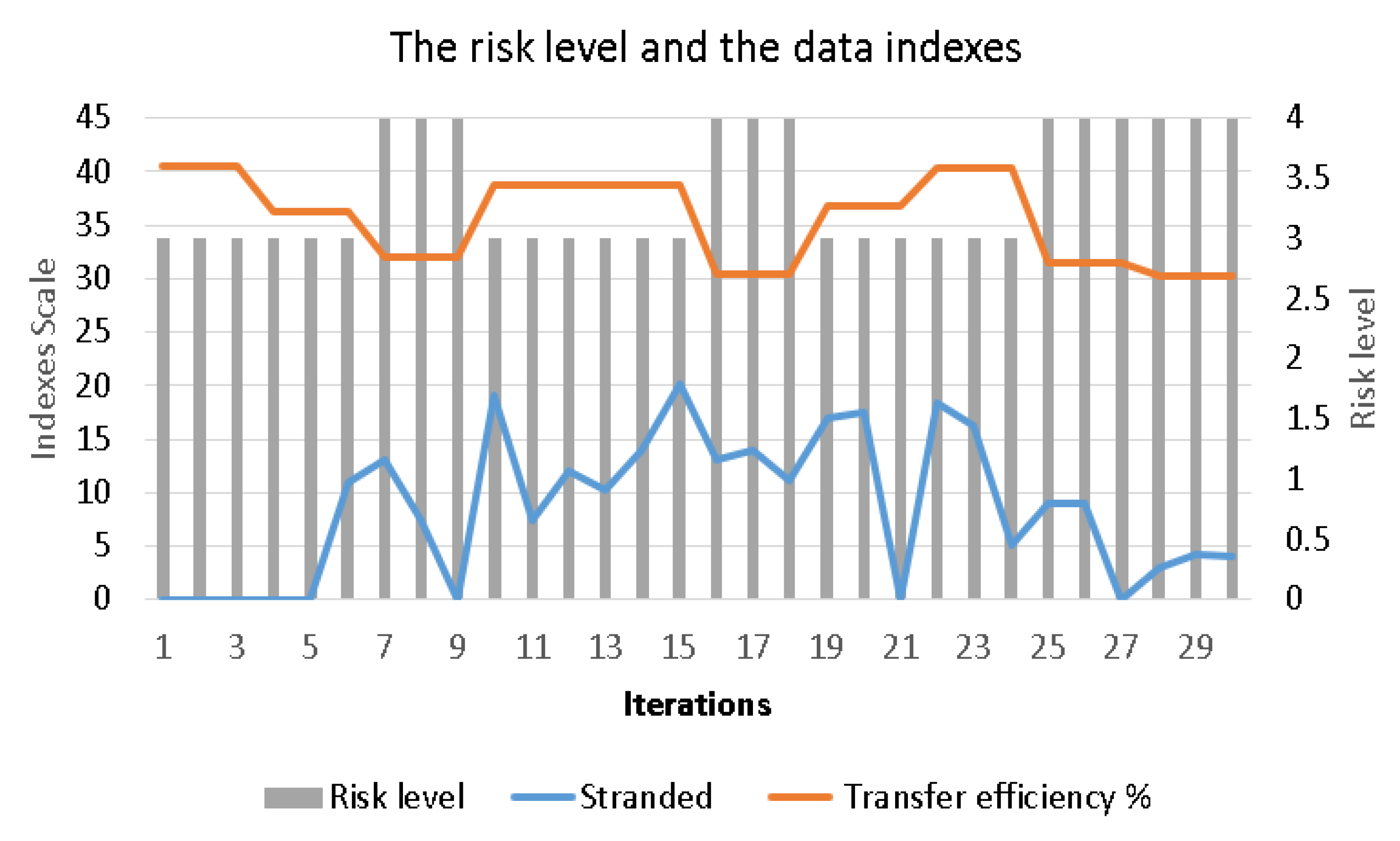
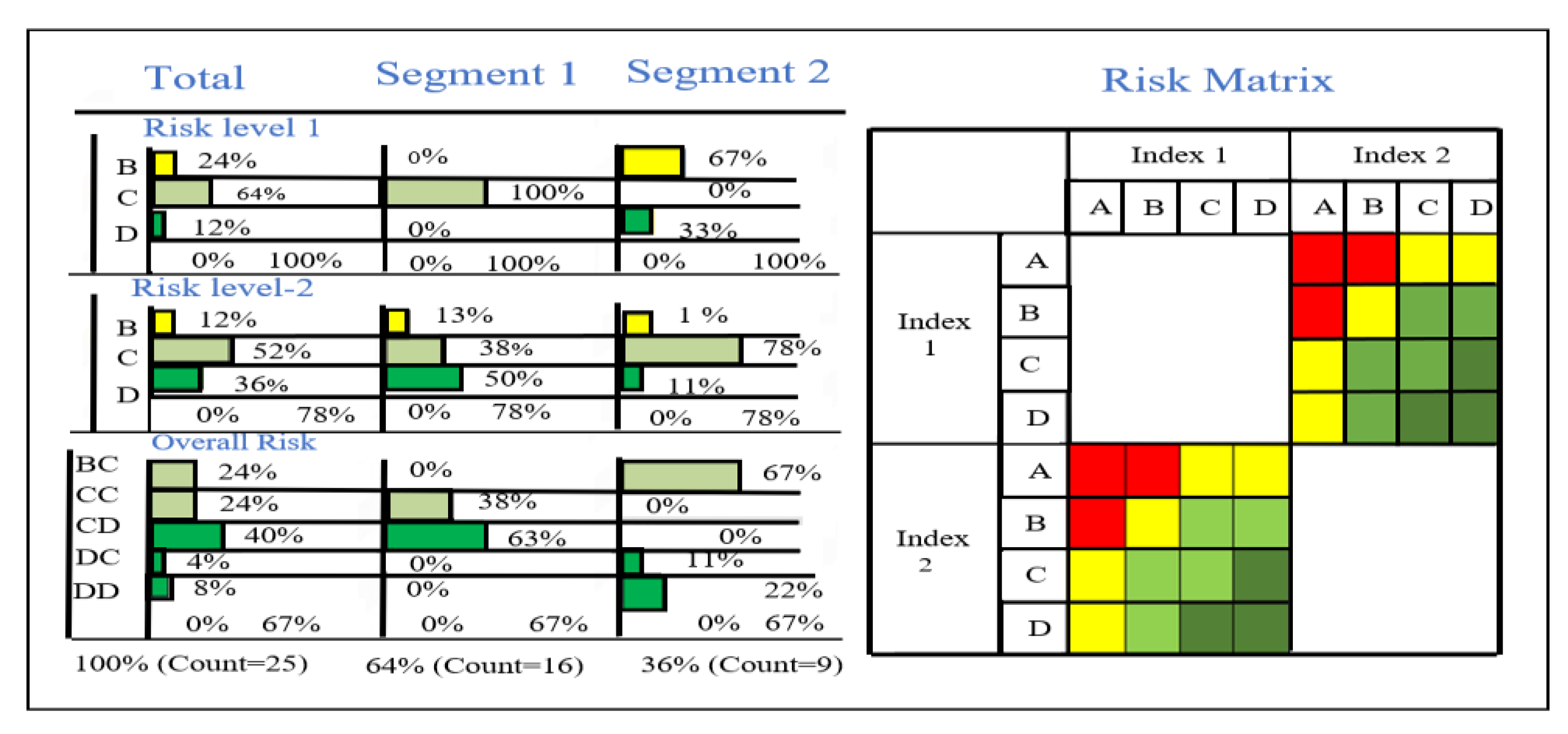
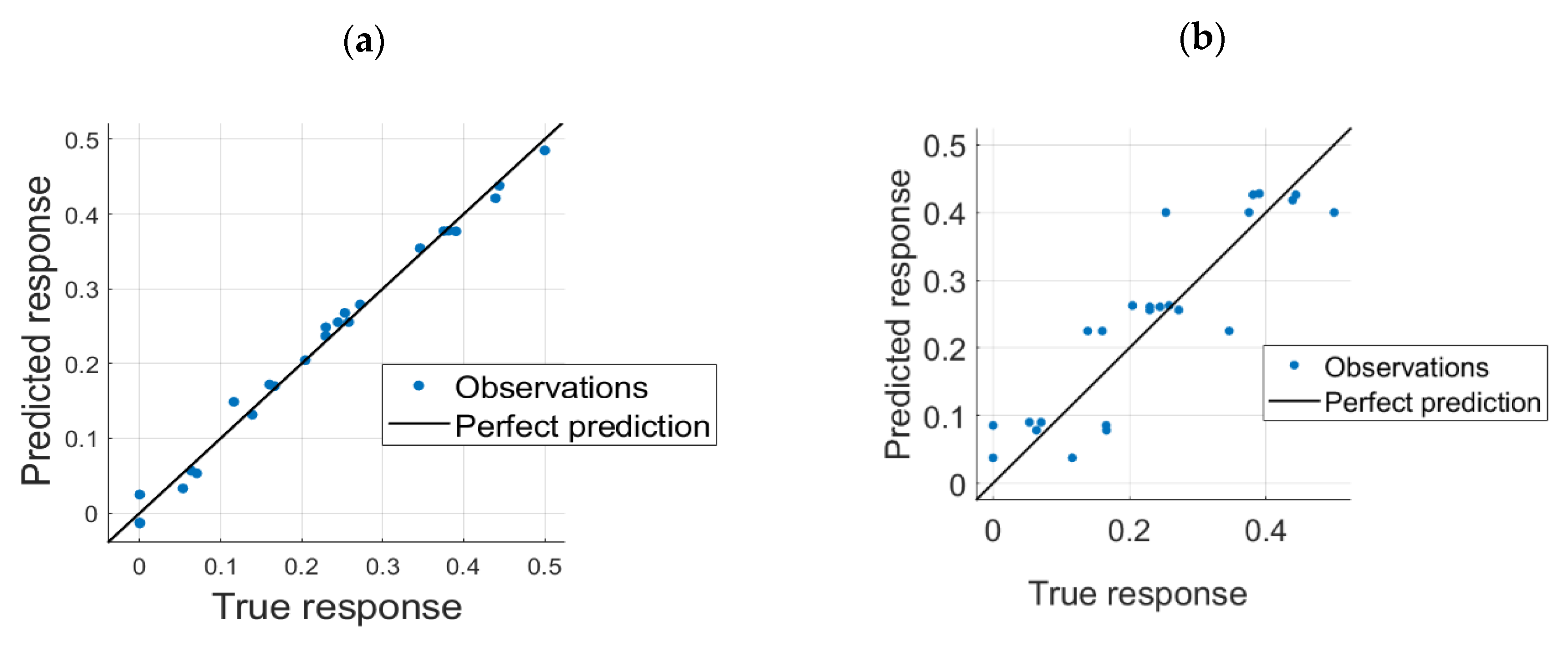
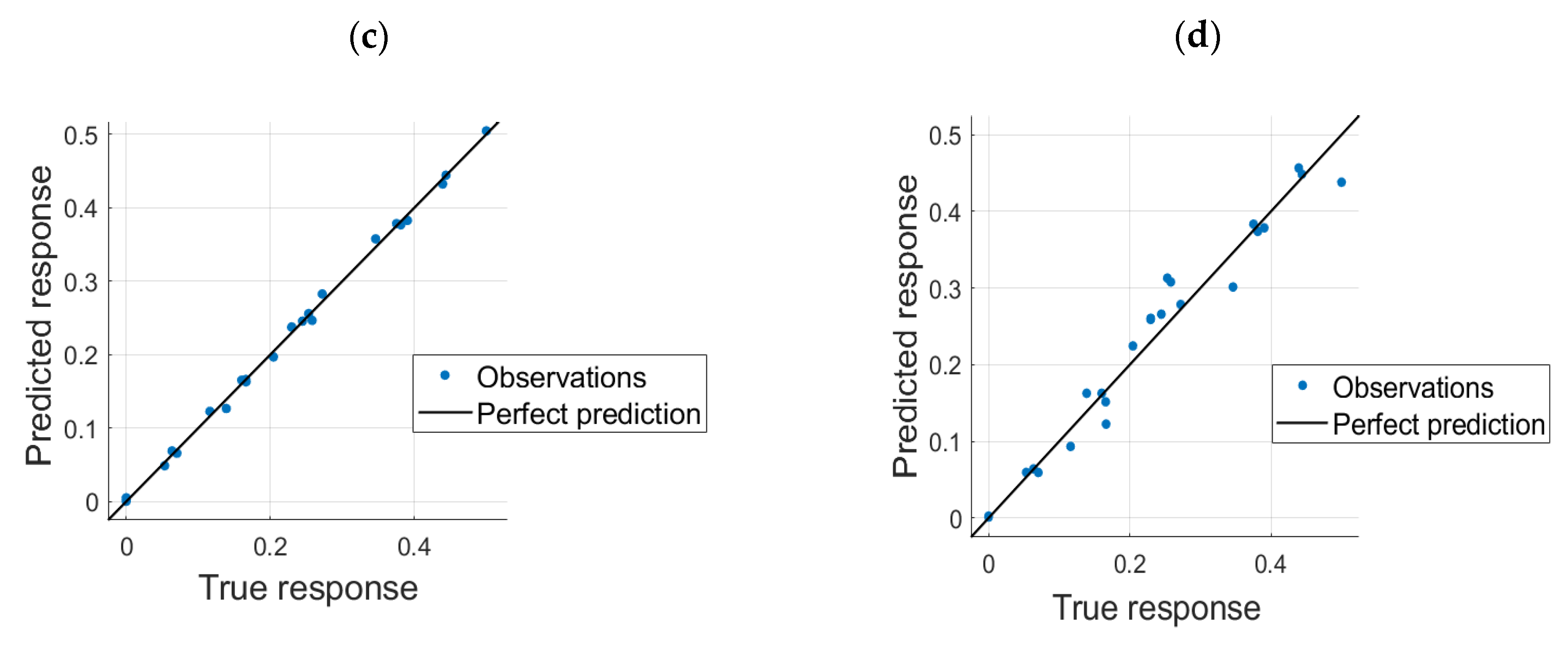
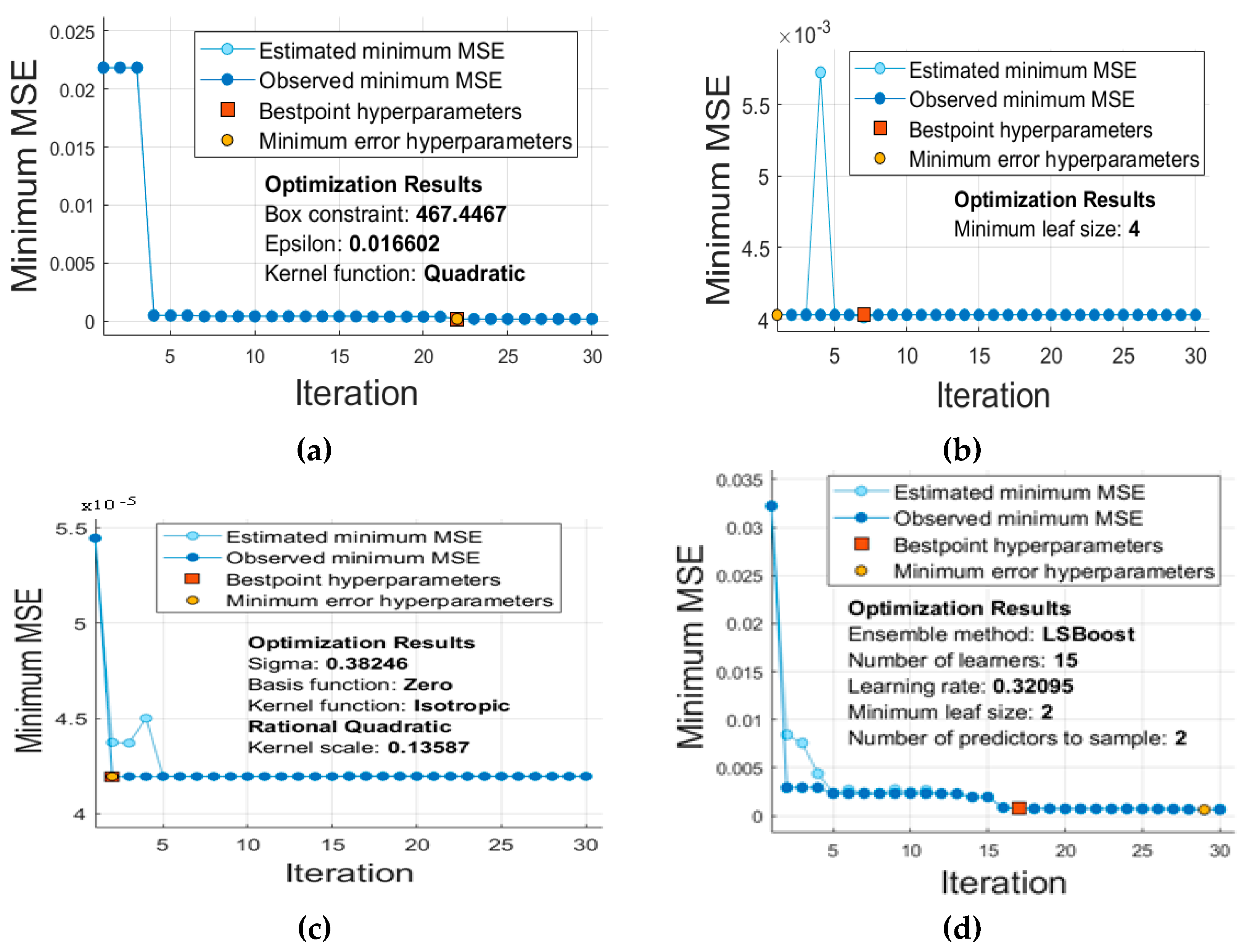
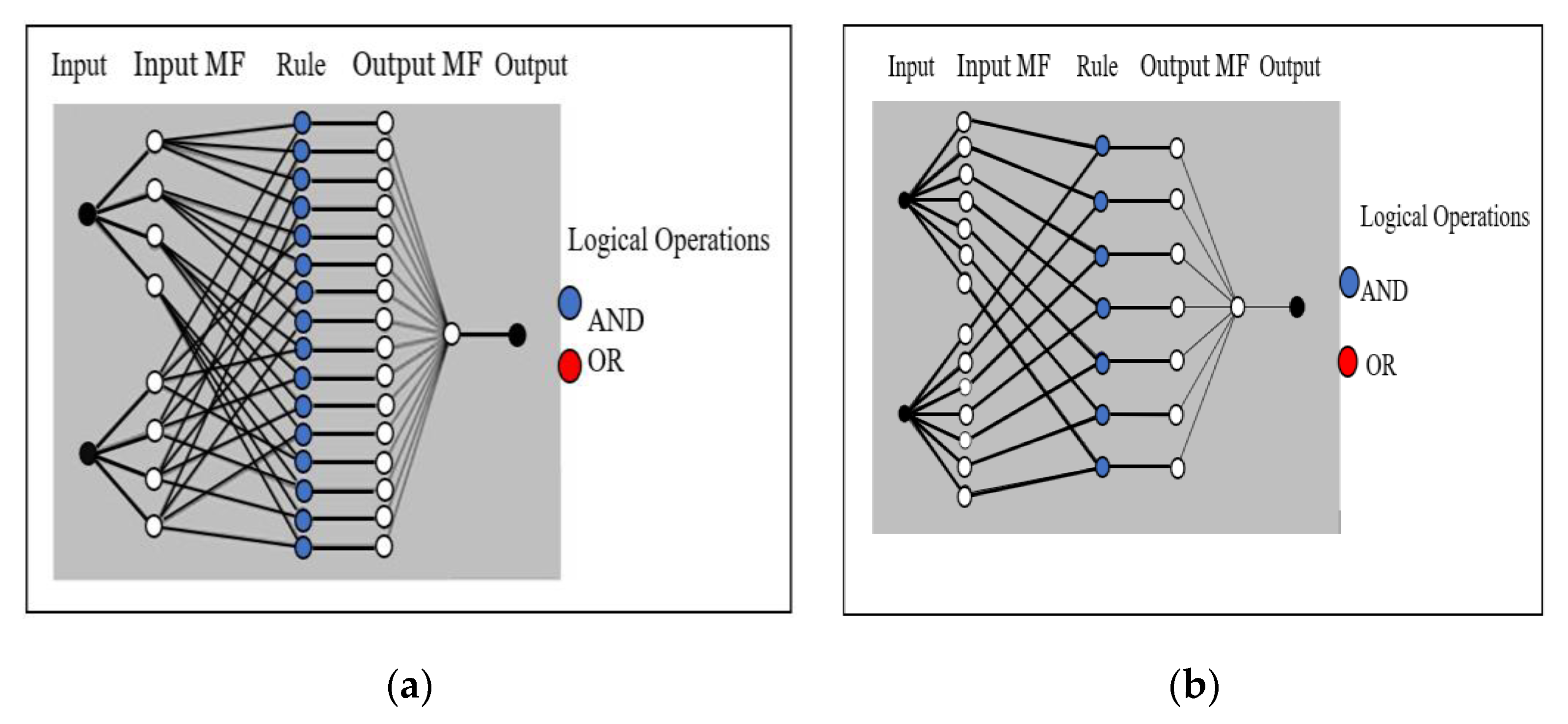
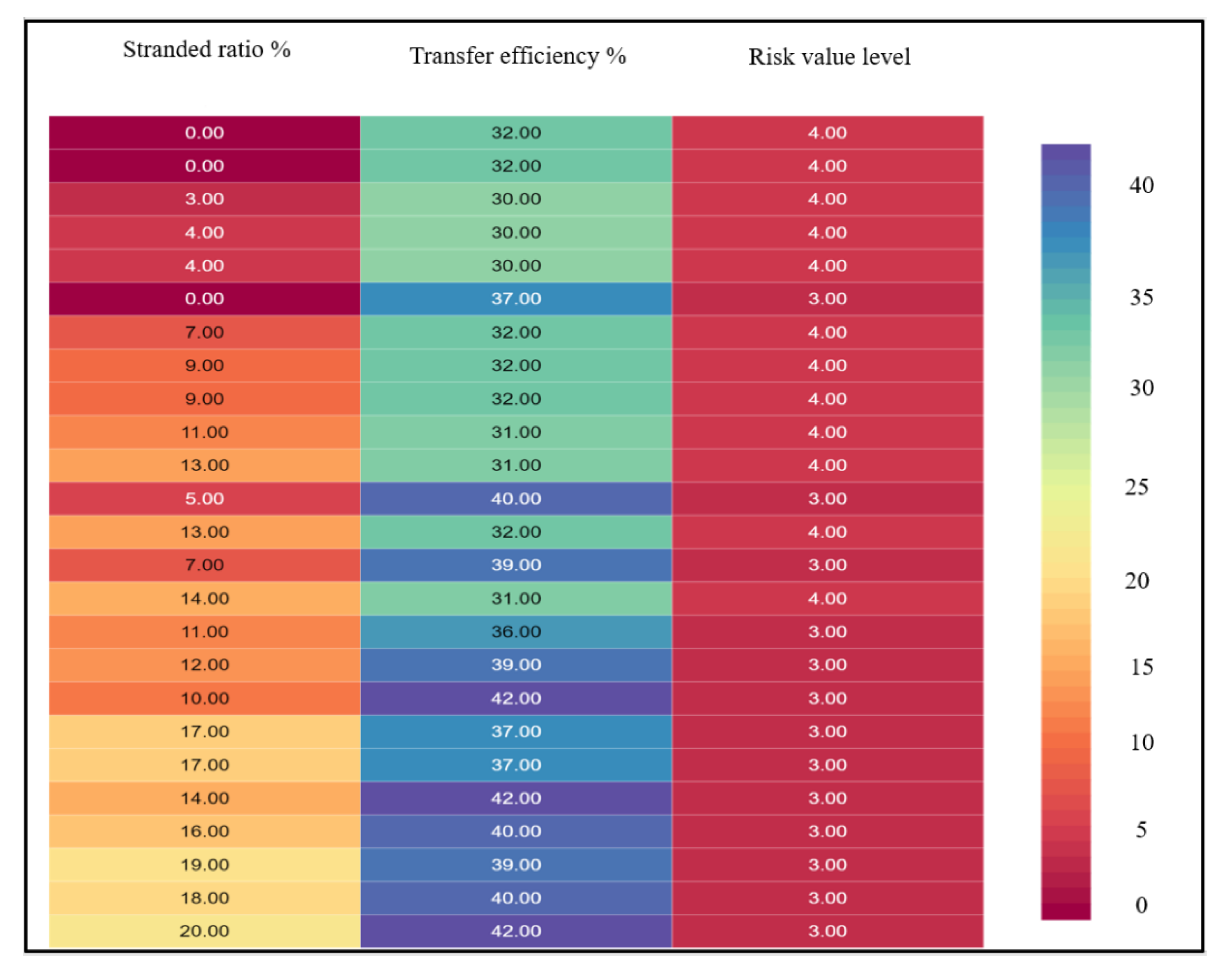
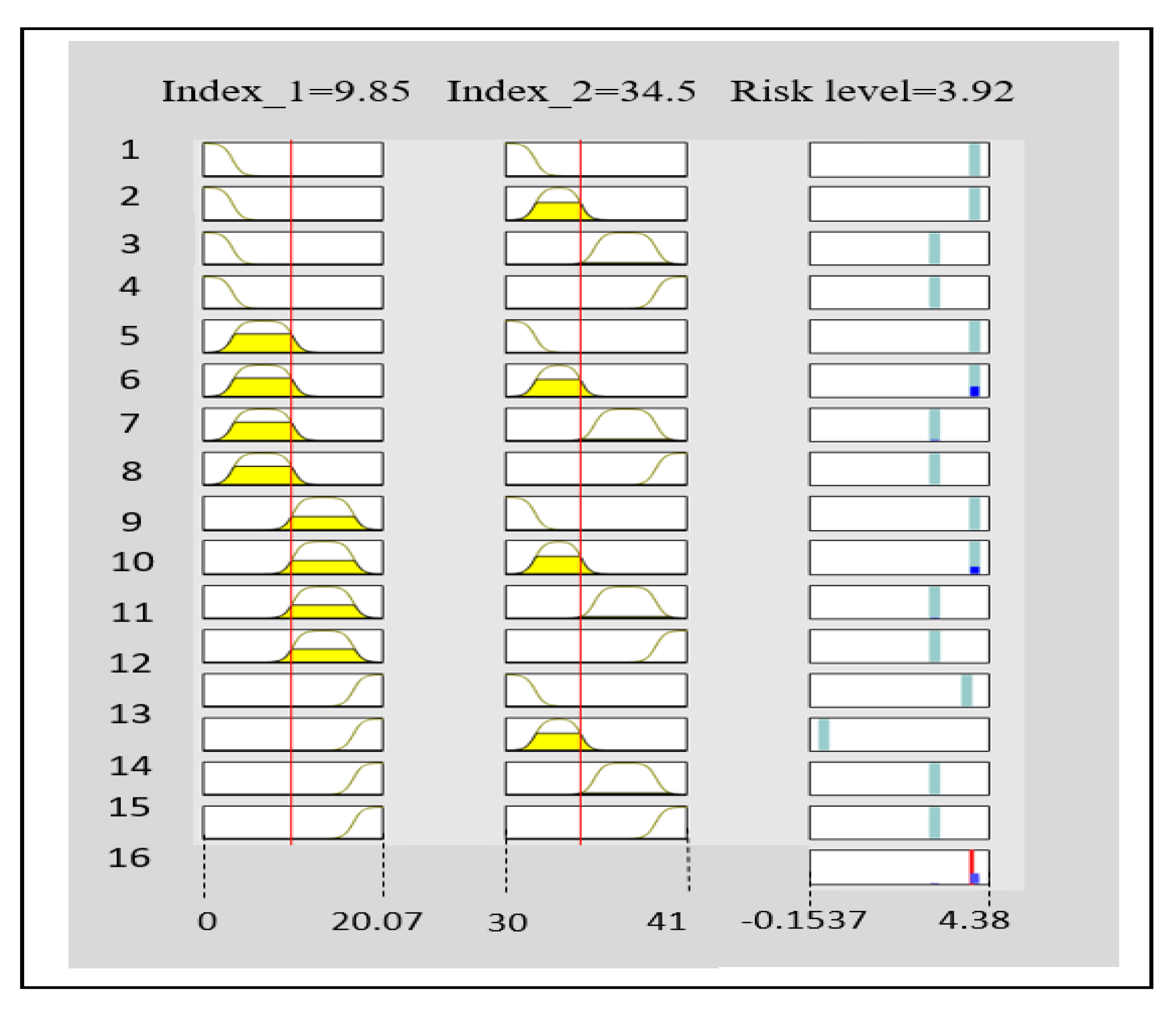
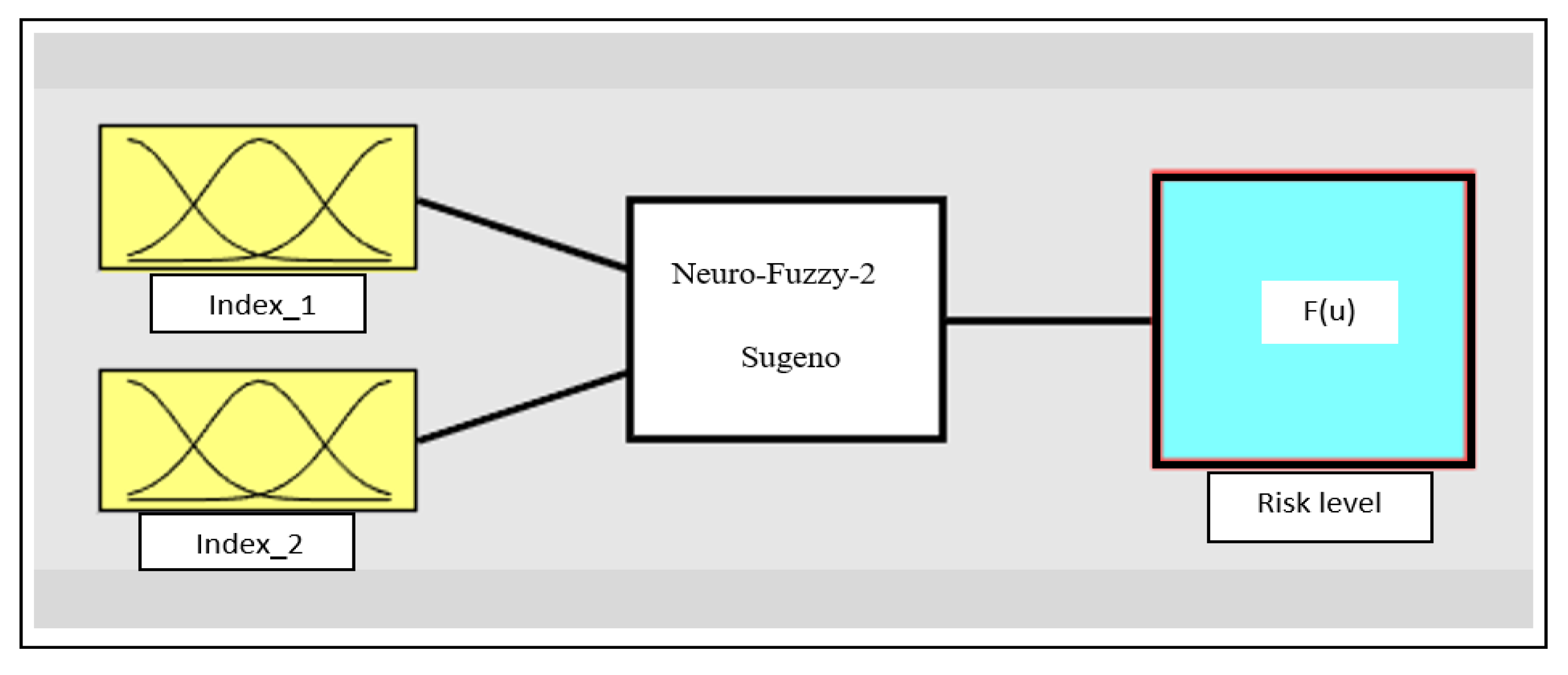
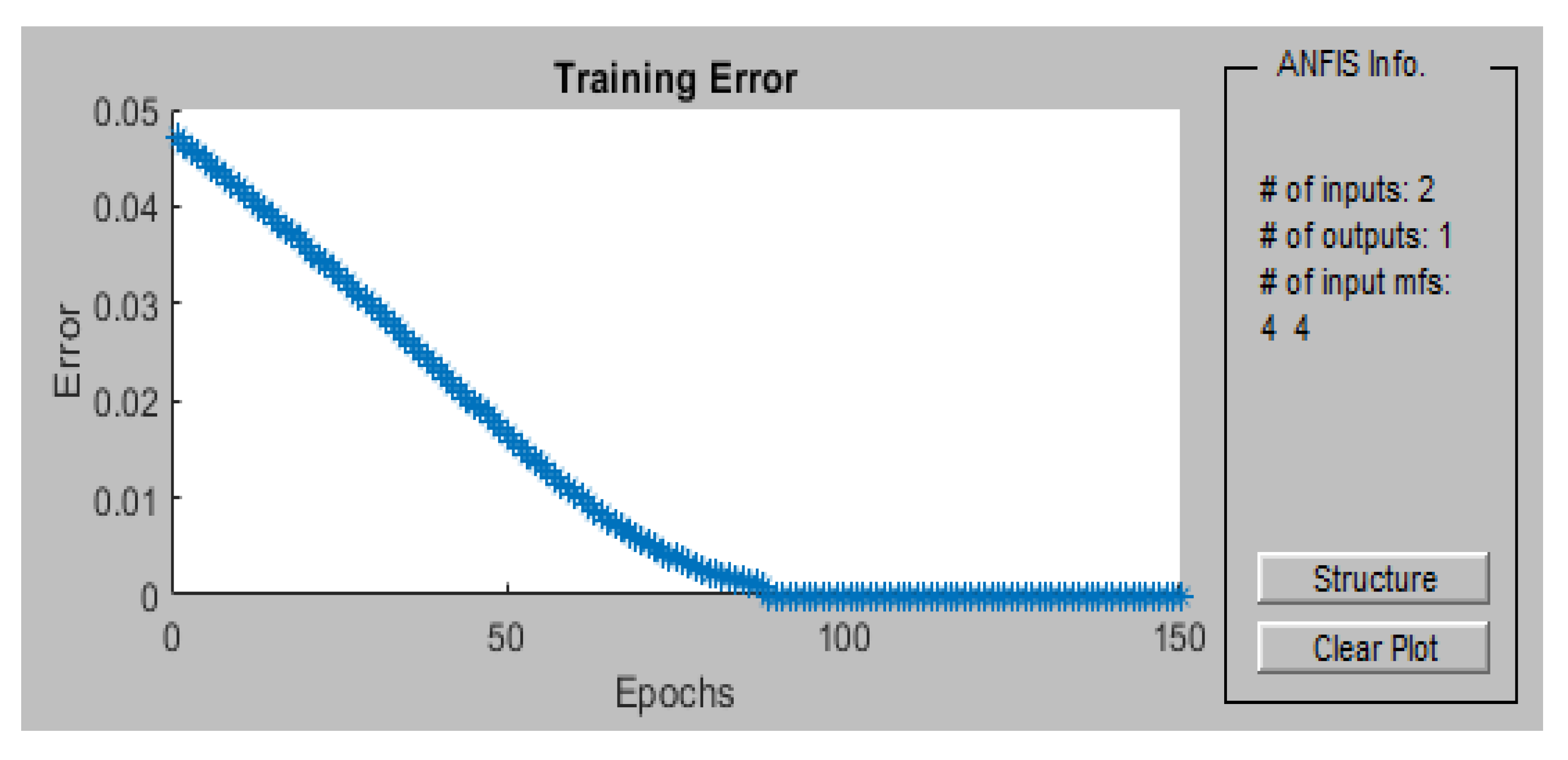
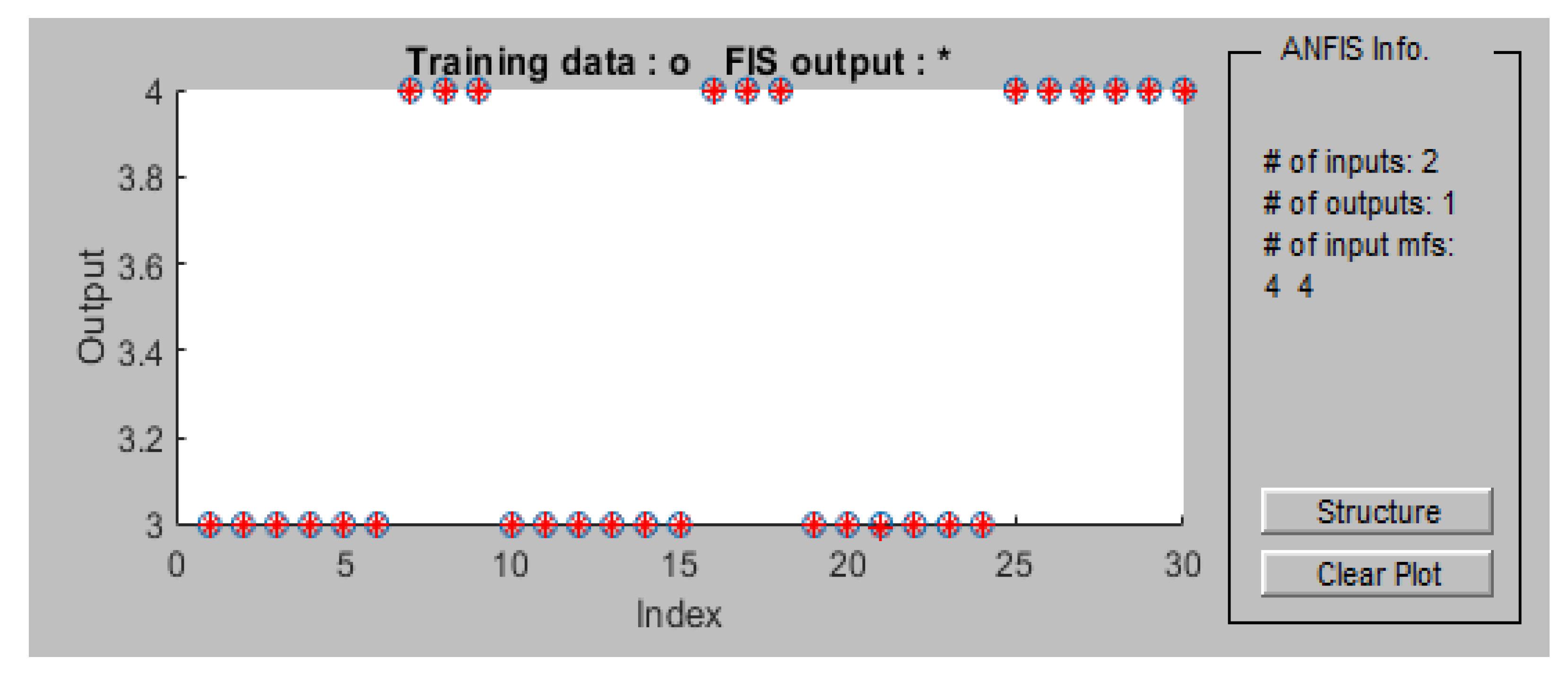
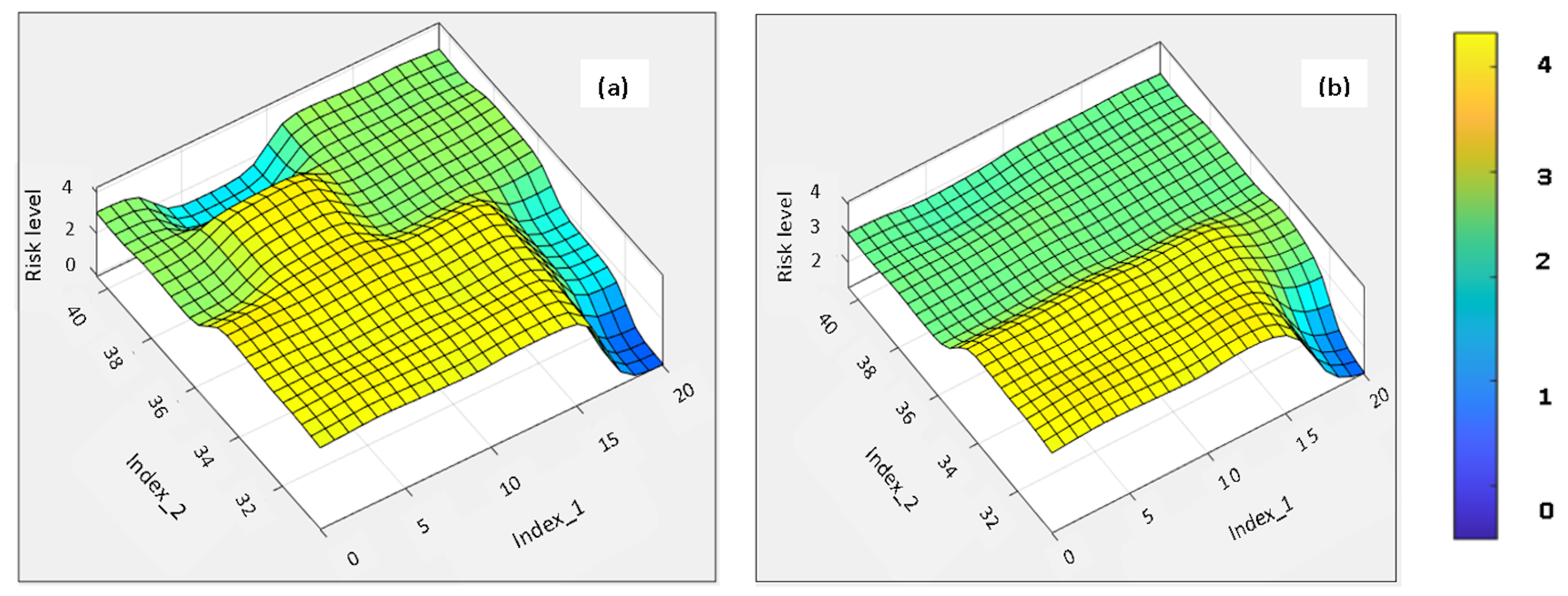
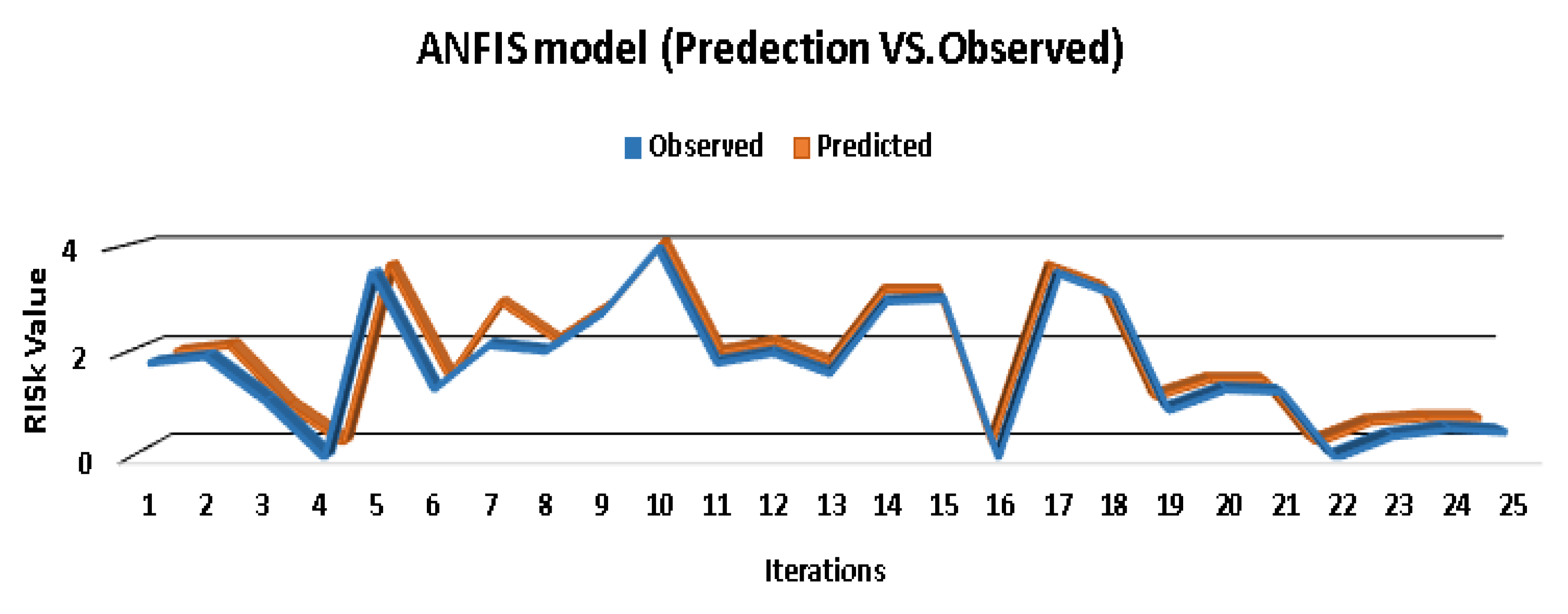
| Reference | Method | Task | Data Source |
|---|---|---|---|
| [27] | Deep learning | Safety prediction of rail transit system | Datasets based on the Beijing metro in China |
| [28] | K-means and the entropy method | The risk of passenger flow congestion | 3rd ring road corridor in Beijing (the bus passenger) |
| [29] | Deep residual neural network framework | Forecast metro station crowd flows | Using the records collected by automated fare collection (AFC) data in Suzhou, China |
| [30] | Interpretative Structural Modeling (ISM) | Urban rail transit operation safety evaluation | Beijing metro |
| [31] | Failure mode and effects criticality analysis (FMECA) | Risk evaluation of railway rolling stock failures | Data collected from the literature, the company’s maintenance management software system called EQUINOX and the UK’s railway performance management software DATASYS BUGLE |
| [32] | Analysed the whole process of safety risk assessment | The concept of the safety risk assessment of large-scale railway stations | Beijing South railway station |
| [33] | Multilevel fuzzy comprehensive evaluation model | Operation safety of the large high-speed railway station. | Guangzhou South railway station in China |
| [34] | Data envelopment analysis (DEA) | Design the risk evaluation index system of crowd agglomeration and stampedes | In 13 subway stations in Beijing |
| [35] | Bayesian network | Safety risk interactions in rail stations | Risk events were collected from 62 stations worldwide and 241 from China |
| [36] | Quantitative statistics for safety risk analysis | Metro incident management | Shanghai metro operation incident database (MOID) |
| [37] | Fuzzy analytical hierarchy | Analysis of operation risk factors of urban rail transit | Experts’ judgement information |
| [17] | Risk evaluation model | For the safety of passengers and improving the operation efficiency in metro stations | A practical application in Beijing’s GuoMao metro station. |
| [38] | Multi-Criteria Decision-Making (MCDM) model | Train derailment risk response strategy | Yangyangcheng station in Shenmu city in China |
| [39] | Nonparametric regression model | Predicting the transfer passenger flow to forecast pedestrian congestions | Transfer passenger flow for one month in the XIDAN transfer station |
| [40] | Grey clustering and dynamic identification method | Passenger flow congestion risk in rail transit hub station | Real-time data of AFC (Automatic Fare Collection) system from Dongzhimen rail transit hub station in China |
| [41] | Combines failure mode and effect analysis (FMEA) and pessimistic–optimistic fuzzy information axiom (POFIA) considering acceptable risk coefficient (ARC) | Evaluate the risk of railway dangerous goods transportation system | The historical data of Chinese railway dangerous goods transportation system (RDNGTS) accidents from 1986 to 2017 |
| [42] | Nonparametric regression model | Forecasting traffic flow incidents | Collected incident-free data in the freeway in San Francisco Bay |
| [43] | Online spatio-temporal | Crowd flow prediction | Dataset of Sydney trains network and the weather data from the Australian Bureau of Meteorology |
| [44] | Fusion of support vector regression and neural network | Predicting abnormal passenger flow | Yangji station in Guangzhou, China |
| [45] | Combining fuzzy petri net (FPN) and fault tree analysis (FTA) | Railway safety risk assessment and control optimization. | The Shijiazhuang high-speed railway station |
| [46] | Algorithm utilizing the cost theory and automatic frequency control (CT-AFC) | Railway passenger flow recognition in the terminal station | A questionnaire survey of the passenger travel characteristics for the passengers of the Shanghai railway, AFC data and dynamic video data |
| [47] | Deep learning method | Analysis of railway accidents | The accident reports from the Federal Railroad Administration (FRA) in the U.S. |
| [48] | Multiscale radial basis function network | Forecasting the irregular fluctuation of subway passenger flows | Transit smart card data in Beijing’s subway |
| [49] | Machine learning for safety at railway stations | Analysis of accidents at railway stations | The history of the accidents at railway stations in the UK |
| [50] | Text mining and natural language process (NLP) techniques | Extraction and analysis of risk factors | Chinese railway accident reports |
| [51] | Hybrid particle swarm optimization and support vector machine PSO–SVM model | A hybrid risk-prediction framework for design safety of metro station construction | Using an expert interview method |
| [52] | Big data and natural language processing | Identify heightened risk on the railway | Reports of railway accidents in the UK from 2008 to 2010 |
| [53] | An ordinal regression model | Assessing safety and security in a railway station as perceived by travellers | Data collected from a survey carried out in the station of Frosinone (Italy) |
| [54] | A safety-related risk assessment model | Design practices regarding passenger hazard | National Thai station design practices as a baseline |
| [55] | Analytic hierarchy process (AHP) | Safety risk assessment of railway station | A Wuhan railway station in China |
| [56] | Dispatching fault log management and analysis database system ((DFLMIS) | Risk early-warning and promoting the safety management level of metro | Shanghai rail transit operation data in China |
| [57] | Cause Consequence Analysis (CCA) and Fuzzy Causal Model (FCM) | Risk analysis initiated by human factors (passengers and operators) | Historical incident data from metro Beijing operational risks in China |
| [58] | Nonlinear combined weighting method based on AHP and entropy-weighted method | Risk assessment of railway freight station | A station in North China |
| Time | Transfer Passenger % | Train Capacity % | Stranded Passengers % | Waiting Passengers % | Stranded Ratio % | Transfer Efficiency |
|---|---|---|---|---|---|---|
| 7:31:30 | 0.77 | 100 | 0.00 | 68.29 | 0 | 1.62 |
| 7:33:30 | 0.65 | 100 | 0.00 | 57.62 | 0 | 1.62 |
| 7:35:30 | 0.78 | 100 | 0.00 | 68.90 | 0 | 1.62 |
| 7:37:30 | 0.78 | 100 | 0.00 | 69.21 | 0 | 1.45 |
| 7:39:30 | 0.76 | 100 | 0.00 | 67.07 | 0 | 1.45 |
| 7:41:30 | 0.84 | 0.83 | 0.40 | 74.70 | 0.11 | 1.45 |
| 7:43:30 | 0.88 | 0.83 | 0.55 | 85.98 | 0.13 | 1.28 |
| 7:45:30 | 0.82 | 0.83 | 0.31 | 83.84 | 0.07 | 1.28 |
| 7:47:30 | 0.75 | 0.83 | 0.00 | 72.56 | 0 | 1.28 |
| 7:49:30 | 0.93 | 0.83 | 0.80 | 82.62 | 0.19 | 1.55 |
| 7:51:30 | 0.83 | 0.83 | 0.32 | 89.02 | 0.07 | 1.55 |
| 7:53:30 | 0.87 | 0.83 | 0.49 | 82.93 | 0.12 | 1.55 |
| 7:55:30 | 0.86 | 0.83 | 0.45 | 85.06 | 0.10 | 1.67 |
| 7:57:30 | 0.89 | 0.83 | 0.62 | 87.80 | 0.14 | 1.67 |
| 7:59:30 | 0.98 | 0.83 | 1.00 | 98.78 | 0.20 | 1.67 |
| 8:01:30 | 0.90 | 100 | 0.63 | 99.09 | 0.13 | 1.22 |
| 8:03:30 | 0.90 | 100 | 0.65 | 92.07 | 0.14 | 1.22 |
| 8:05:30 | 0.87 | 100 | 0.51 | 89.63 | 0.11 | 1.22 |
| 8:07:30 | 0.93 | 100 | 0.80 | 92.68 | 0.17 | 1.47 |
| 8:09:30 | 0.95 | 100 | 0.88 | 100.00 | 0.17 | 1.47 |
| 8:11:30 | 0.72 | 100 | 0.00 | 81.40 | 0 | 1.47 |
| 8:13:30 | 0.92 | 0.83 | 0.75 | 81.71 | 0.18 | 1.61 |
| 8:15:30 | 0.93 | 0.83 | 0.80 | 97.56 | 0.16 | 1.61 |
| 8:17:30 | 0.96 | 100 | 0.25 | 100 | 0.05 | 1.61 |
| 8:19:30 | 1.00 | 100 | 0.42 | 93.29 | 0.09 | 1.26 |
| 8:21:30 | 1.00 | 100 | 0.43 | 96.65 | 0.09 | 1.26 |
| 8:23:30 | 0.81 | 100 | 0.00 | 79.88 | 0 | 1.26 |
| 8:25:30 | 0.93 | 100 | 0.12 | 82.62 | 0.03 | 1.21 |
| 8:27:30 | 0.94 | 100 | 0.18 | 85.98 | 0.04 | 1.21 |
| 8:29:30 | 0.94 | 100 | 0.15 | 86.59 | 0.04 | 1.21 |
| Result | Description (Retention Rate of the Platform) | Description (Transfer Efficiency) | Risk Levels Indexes |
|---|---|---|---|
| Very unlikely | Full capacity and have chance to ride without being stranded | Passengers can move easily | D |
| Unlikely | A few stand and wait for the next train | A few lines before the lift and stairs | C |
| Likely | Some are waiting for the next train | Some lines before the lift and stairs | B |
| Very likely | Highly crowded and no chance to ride | Very slow movement | A |
| Index 1 | Index 2 | Risk Levels of Indexes 1 & 2 | Risk Values Index 1 | Ratio Range of Index 2 | The Scale Factor (R) of Index 2 | Risk Value Level | ||||||||
|---|---|---|---|---|---|---|---|---|---|---|---|---|---|---|
| A | B | C | D | A | B | C | D | |||||||
| Index 1 | A | D | R ≤ 0 | 1.3 < R ≤ 1 | 32.5 ≤ R ≤ 0 | 4 | ||||||||
| B | ||||||||||||||
| C | C | 0 < R ≤ 15 | 1.7 < R ≤ 1.3 | 42.5 < R < 32.5 | 3 | |||||||||
| D | ||||||||||||||
| Index 2 | A | B | 15 < R < 50 | 2 < R ≤ 1.7 | 50 < R ≤ 42.5 | 2 | ||||||||
| B | ||||||||||||||
| C | A | R ≥ 50 | R ≥ 2 | R ≥ 50 | 1 | |||||||||
| D | ||||||||||||||
| Model Type | RMSE | R2 | MSE | MAE |
|---|---|---|---|---|
| Optimizable SVM | 0.013656 | 0.99 | 0.0001864 | 0.01128 |
| Optimizable Tree | 0.063478 | 0.82 | 0.0040295 | 0.051834 |
| Optimizable GPR | 0.00647 | 1 | 0.00004194 | 0.0054809 |
| Optimizable Ensemble | 0.02726 | 0.97 | 0.0007431 | 0.020145 |
| ANFIS Info | MF | Number of Nonlinear Parameters | Training RMSE | Testing RMSE | ||
|---|---|---|---|---|---|---|
| Back Propagation | Hybrid | Back Propagation | Hybrid | |||
| Grid partition Method | trimf | 24 | 0.073364 | 0.000119 | 0.214272 | 0.234563 |
| trapmf | 32 | 0.064496 | 0.000061 | 0.152923 | 0.771647 | |
| gbellmf | 24 | 0.063835 | 0.000001 | 0.100628 | 0.103621 | |
| gaussmf | 16 | 0.063897 | 0.000001 | 0.176282 | 0.079462 | |
| Gauss2mf | 32 | 0.074480 | 0.000001 | 0.136584 | 0.87736 | |
| pimf | 32 | 0.058077 | 0.000061 | 0.19069 | 3.89485 | |
| dsigmf | 32 | 0.071541 | 0.000000 | 0.117291 | 0.726872 | |
| psigmf | 32 | 0.039306 | 0.000000 | 0.717619 | 0.720104 | |
| Number of linear parameters | 48 | |||||
| Number of Epochs | 150 | |||||
| Number of nodes | 53 | |||||
© 2020 by the authors. Licensee MDPI, Basel, Switzerland. This article is an open access article distributed under the terms and conditions of the Creative Commons Attribution (CC BY) license (http://creativecommons.org/licenses/by/4.0/).
Share and Cite
Alawad, H.; An, M.; Kaewunruen, S. Utilizing an Adaptive Neuro-Fuzzy Inference System (ANFIS) for Overcrowding Level Risk Assessment in Railway Stations. Appl. Sci. 2020, 10, 5156. https://doi.org/10.3390/app10155156
Alawad H, An M, Kaewunruen S. Utilizing an Adaptive Neuro-Fuzzy Inference System (ANFIS) for Overcrowding Level Risk Assessment in Railway Stations. Applied Sciences. 2020; 10(15):5156. https://doi.org/10.3390/app10155156
Chicago/Turabian StyleAlawad, Hamad, Min An, and Sakdirat Kaewunruen. 2020. "Utilizing an Adaptive Neuro-Fuzzy Inference System (ANFIS) for Overcrowding Level Risk Assessment in Railway Stations" Applied Sciences 10, no. 15: 5156. https://doi.org/10.3390/app10155156






